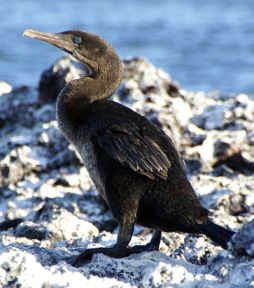To fly or not to fly?
Evolution can do funny things. Like producing the amazing feat of flight in a lineage of reptiles, which over time led to an adaptive radiation seldom rivaled in the history of animals.
And then producing, in some 30 species of birds, the loss of the adaptation altogether. 
It would seem a ridiculous thing to do, to give up the power of flight, when you can fly. Certainly, if I could fly, I wouldn’t bother giving it up.
That’s Rory Wilson, a professor of aquatic biology at the University of Wales Swansea. He’s pictured here with his first love and the subject of his Ph.D.: the African penguin. His most recent work gets up-close and personal with another flightless bird, the Galápagos cormorant, sometimes known as – you guessed it – the flightless cormorant. Wilson and his colleagues wondered what led this bird to lose the ability to fly when none of the other 60 waterbirds in its order – including pelicans, frigatebirds and boobies – have done the same.
Listen to Dr. Wilson discuss why some birds have evolved flightlessness in this podcast, the November installment of ESA’s Field Talk series.
 In birds, flight most likely originated as an escape response. Reptilian predecessors to modern-day birds would scamper away from predators, leading to the evolution of wings, feathers and muscles that lifted the animals off the ground, much to the chagrin of frustrated four-legged carnivores. Once they took to the air, the resourceful birds then co-opted this adaptation for other functions to boost their survival, such as traveling much greater distances in search of food.
In birds, flight most likely originated as an escape response. Reptilian predecessors to modern-day birds would scamper away from predators, leading to the evolution of wings, feathers and muscles that lifted the animals off the ground, much to the chagrin of frustrated four-legged carnivores. Once they took to the air, the resourceful birds then co-opted this adaptation for other functions to boost their survival, such as traveling much greater distances in search of food.
In the Galápagos islands, though, the situation is a bit different. There are no terrestrial predators, so using flight as an escape response isn’t important. The warm Pacific water and nutrient upwelling surrounding the Galápagos also make the coasts rich in seafloor prey, potentially reducing the need to travel great distances to find food.
Wilson’s team tested this idea by tagging 95 birds with GPS loggers and time-depth recorders to get a sense of their position and movement in the water over a 24-hour period. Sure enough, the birds routinely dove in shallow waters at depths of only 20 percent of their deepest dives. The combination of release from predation and the ability to find consistent food close to shore led to these birds kicking their flying habit in favor of a streamlined body suited for diving.
Though his research is motivated by the love of these flightless birds, the new object of Wilson’s affection is of the electronic kind. He hopes that the loggers his team uses can someday be made small and versatile enough to be used to track the behavior of virtually any animal. So far the loggers have been used on such animals as badgers, cheetahs, seals, whale sharks, albatrosses, crocodiles and turtles. To Wilson, the possibilities are endless. As he says, there are no books written about the daily activities of these animals. Wilson likes to think the loggers’ data as a book written by the animal itself, telling you, up to the minute, exactly what it’s doing and where it’s doing it.